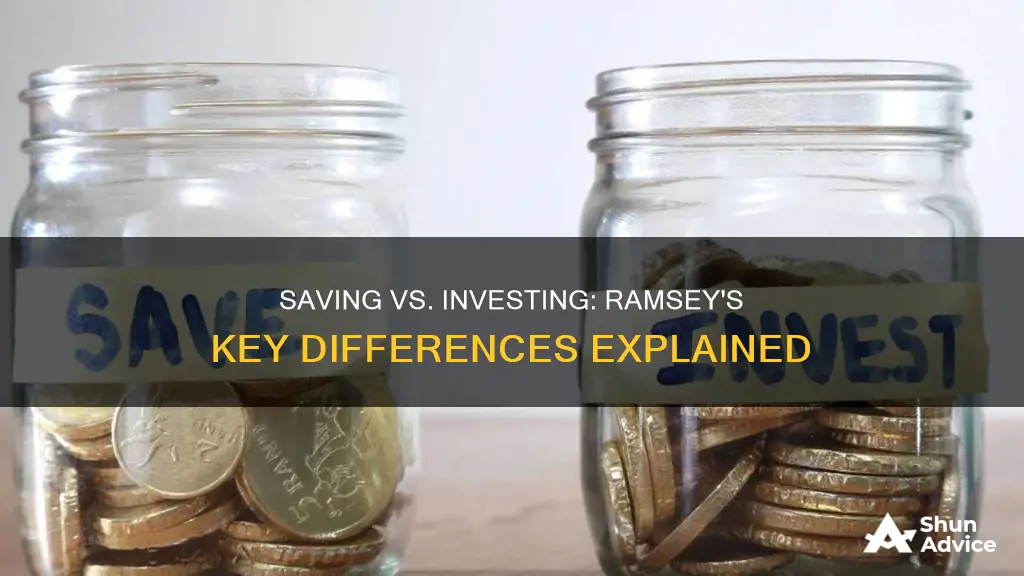
Saving and investing are both important components of a healthy financial plan. While they are not the same thing, they are both strategies that help you accumulate money. Saving typically means storing money safely so that it is available when needed and has a low risk of losing value. On the other hand, investing comes with risk but also the potential for higher returns. Finance expert Dave Ramsey recommends that you save enough to cover emergencies and short-term purchases, but that you should invest for your longer-term goals.
| Characteristics | Values |
|---|---|
| Risk | Saving typically has a lower return but with virtually no risk. Investing allows for higher returns but comes with the risk of loss. |
| Time horizon | Saving is typically for the short-term, such as for purchases or emergencies. Investing is typically for the long-term, such as for retirement or children's college funds. |
| Examples | Saving examples include savings accounts, money market accounts, and certificates of deposit (CDs). Investing examples include stocks, bonds, mutual funds, and ETFs. |
| Returns | Saving returns are generally low but with minimal fees. Investing returns can be higher but are not guaranteed and depend on the performance of the investment. |
| Liquidity | Savings are generally highly liquid, allowing quick access to funds. Investments can also be liquid, but it is recommended to hold them for longer periods to maximise returns. |
| Inflation | Savings may lose purchasing power due to inflation. Investments can help beat inflation over the long term. |
What You'll Learn

Saving is low-risk, investing is higher-risk
Saving and investing are both important components of a healthy financial plan. While they are different, they are both strategies that help you accumulate money. However, saving is low-risk, whereas investing is higher-risk.
Saving money means storing it safely so that it is available when you need it and it has a low risk of losing value. Savings are generally low-risk, meaning your money is safe, but the interest rates received are also low. Savings accounts, for example, are protected by the Federal Deposit Insurance Corporation (FDIC) in the US, which guarantees bank accounts up to $250,000 per depositor. While this means that your money is safe, it also means that your returns will be lower.
When you invest, you take on more risk in exchange for the potential for higher returns. Investing involves putting your money into financial instruments such as stocks, bonds, and mutual funds. There is always the risk of losing money when investing. For example, if you invest in a company and it goes bankrupt, your investment could become worthless. However, investing in a variety of companies and industries can reduce this risk.
The level of risk and potential return you are comfortable with will depend on your financial goals and risk tolerance. Saving is generally a good idea for short-term goals, such as saving for a new phone or a vacation, while investing is better suited for long-term goals, such as saving for retirement or a down payment on a house.
While saving is safer than investing, investing typically results in higher accumulated wealth over time. This is because investments such as stocks often have much higher returns than savings accounts. Additionally, investing in a diverse range of stocks can help you beat inflation and increase your purchasing power over time.
In summary, saving is a low-risk way to store your money safely and achieve short-term financial goals. On the other hand, investing is higher-risk and offers the potential for higher returns, making it better suited for long-term wealth accumulation. A balanced approach that includes both saving and investing can help build wealth and protect against financial shocks.
Savings or Investments: The Best Way to Utilize Your 100K
You may want to see also

Saving is for short-term goals, investing is for long-term goals
Saving is for short-term goals, while investing is for long-term ones.
Saving is a crucial part of any financial plan, but it should be combined with other forms of investing to achieve a balanced approach. Savings are generally low-risk, meaning your money is safe, but the interest rates received are also low. Savings accounts, for example, are a good option if you need to access your money in the near future and can't afford to lose any of it. They are also useful for building an emergency fund, which financial experts recommend should cover three to six months' worth of living expenses.
Investing, on the other hand, is a way to grow your money over time by putting it into financial instruments such as stocks, bonds, and mutual funds. It typically comes with a longer-term horizon, such as for children's college funds or one's retirement. Investing involves taking on some risk, but it also has the potential for higher returns. For instance, the Standard & Poor's 500 stock index (S&P 500) has returned about 10% annually.
While saving is a great way to meet short-term financial goals and prepare for unexpected situations, investing is crucial for achieving long-term financial goals. However, investing also comes with the risk of losing money. Therefore, it is important to find the right balance between saving and investing to build wealth, protect against financial shocks, and provide a solid foundation for a more secure financial future.
Smart Saving and Investing Strategies for Your Kids' Future
You may want to see also

Savings are liquid, investments are less so
Savings are liquid, but investments are less so. This is one of the key differences between saving and investing. Savings accounts are designed to be easily accessible, allowing you to withdraw your money as and when you need it. On the other hand, investments are generally less liquid, as the money is often tied up for longer periods to allow for growth.
The level of liquidity in savings and investments is influenced by the nature of the assets involved. Savings typically involve low-risk, stable assets like savings accounts, money market accounts, and certificates of deposit (CDs). These accounts offer high liquidity, enabling you to access your funds quickly without significant penalties.
In contrast, investments often include assets such as stocks, bonds, mutual funds, and exchange-traded funds (ETFs). While these investments offer the potential for higher returns, they usually come with a longer-term horizon. This means that you may need to hold onto your investments for a more extended period to ride out market fluctuations and maximise returns. As a result, investments are generally less liquid than savings, and early withdrawal could result in penalties or losses.
It is important to note that the liquidity of investments can vary depending on the specific type of investment. For example, stocks, bonds, and ETFs can typically be converted into cash relatively quickly, providing a higher level of liquidity compared to other types of investments. However, other investments, such as property or certain types of businesses, may take much longer to liquidate and access the funds.
Therefore, when considering the differences between savings and investments, it is essential to understand the trade-off between liquidity and potential returns. Savings provide high liquidity and low risk but often result in lower returns. In contrast, investments offer the opportunity for higher returns but usually come with reduced liquidity and increased risk.
Explore Saving and Investment Options for Your Future
You may want to see also

Savings have low returns, investments have higher returns
Savings accounts are generally considered a safe, low-risk option for storing money. However, the trade-off for this security is that savings accounts offer low returns. Money in savings accounts is paid a low wage as it works for you, and the interest rates received are also low. This means that you could be missing out on the potential for higher returns from riskier investments.
When you invest, you have a greater chance of losing your money than when you save. However, investing also provides the opportunity to earn more money than when you save. This is the trade-off between the higher risk of investing and the potential for greater rewards.
For example, the Standard & Poor's 500 stock index (S&P 500) has returned about 10% annually over time, which is much higher than the returns offered by most savings accounts. Additionally, if you invest in a diversified portfolio of stocks, you are likely to beat inflation over the long term and increase your purchasing power.
It's important to note that investing does come with risks, and there is no guarantee that you will make money. The value of your assets can fluctuate, and there is always the possibility of losing some or all of your investment capital. However, by investing consistently over time and maintaining a long-term perspective, you can increase your chances of achieving higher returns.
In summary, while savings accounts offer low returns and are considered a safe option, investing provides the potential for higher returns. The right choice between saving and investing depends on your financial goals, risk tolerance, and time horizon. It is generally recommended to have a balanced approach that includes both saving and investing to build wealth and protect against financial shocks.
Emergency Savings: Invest or Keep?
You may want to see also

Savings are straightforward, investments are more complex
Saving money is straightforward and simple. It involves putting money away in a safe place, such as a savings account, money market account, or certificate of deposit (CD). These options offer a low risk of losing value and are easily accessible when needed. Saving is an excellent strategy for achieving short-term financial goals and preparing for unexpected expenses. However, the trade-off is that savings accounts typically offer low-interest rates, which may not keep up with inflation. As a result, there is a chance of losing purchasing power over time.
On the other hand, investing is more complex and involves taking on some level of risk. It entails putting money into financial instruments such as stocks, bonds, and mutual funds, with the potential for higher returns over the long term. Investing is typically associated with a longer time horizon, such as saving for retirement or a child's college education. While investing offers the opportunity for higher returns, there is always the risk of losing money. It is important to diversify one's portfolio and choose investments that align with one's goals, risk tolerance, and time horizon.
The main difference between saving and investing lies in the level of risk and potential returns. Saving usually results in lower returns but with minimal risk, while investing offers the opportunity for higher returns at the cost of taking on more risk. Saving is generally more straightforward and accessible, while investing can be more complex and may require research and a long-term perspective.
Public Saving and Investment: Two Sides of the Same Coin?
You may want to see also
Frequently asked questions
Saving typically results in a lower return but with almost no risk. On the other hand, investing allows for the opportunity to earn a higher return but you take on the risk of loss.
Some pros of saving include providing a financial safety net for unexpected events, liquidity for purchases and other short-term goals, and being safe from loss. However, some cons of saving include missing out on potential higher returns from riskier investments and losing purchasing power due to inflation.
Some pros of investing include the potential for higher returns than savings accounts, the ability to grow your wealth over time, and the opportunity to help achieve long-term financial goals. Some cons of investing include the risk of loss, the need for discipline and a long-term perspective, and potentially requiring longer time horizons.







